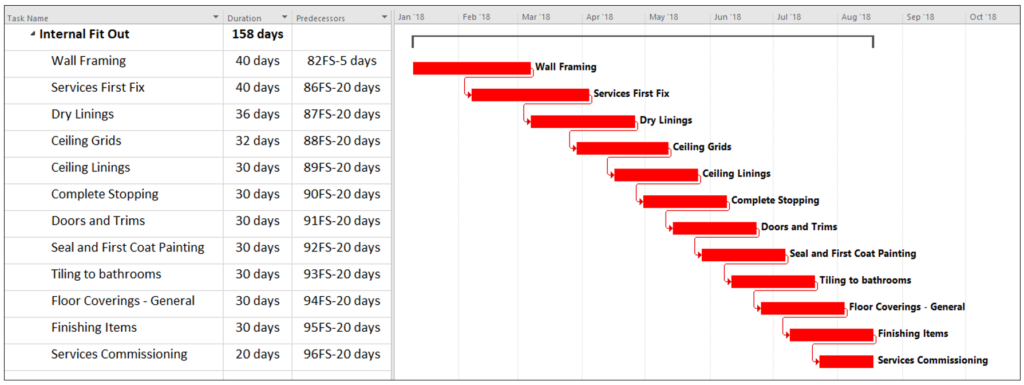
Look at your construction programme schedule and ask yourself these three questions:
If the answer to any question is No, then you have a problem, if the answer to all 3 questions is No, then you have a big problem.
Why does it matter?
When you submit your offer to construct a project to a client, there are 2 questions that you are answering
The answers you provide to these questions form the cornerstones of the construction contract, and the implications are far reaching. Under-estimation of either point can cost you very dearly. So why is so much effort usually put into one and not the other? In this article I’m going to attempt to show you why you shouldn’t gamble your profit on a bunch of blind guesses. After all it’s a business not a day at the races.
How much?
As a matter of course, all reasonable, sober-minded contractors will spend a lot of time working out exactly how much it is going to cost them to carry out a build.
Their estimators carefully study the plans, to pick up all the work that needs to be done. They get quotes from subcontractors for the specialist works to be carried out and negotiate with suppliers for the best rates on the materials and equipment they will need to use.
Once they have carefully collated these costs, and only then, will they add a margin for profit and overheads, and quote a firm price.
Obviously, there is a lot of science and effort riding on the price being right, because that’s what they will get paid. If they get it wrong and it’s too low, they pay the extra, and every dollar in extra cost is a dollar less profit. The contractor carries all of that risk and consequently does his best to reduce or eliminate it.
How long?
When it comes to the programme, things often tend to get decidedly sketchy. Compared to estimating, construction programming is a much darker art with far fewer practitioners; and requiring both an in-depth knowledge of construction techniques and methods, as well as a high level of competency in the use of specialist software such as Microsoft Project or Primavera P6.
The programme is the master plan that sets out how the project will be built, it is a logical step by step breakdown of all the work to be carried out in order to build the project. As a result, it identifies the relationships between the various tasks and calculates the time and resources needed to complete the job.
This then sets the expected due date for completion of the contract. If the programme says 50 weeks, - in the absence of any claimable variations or delays, that’s how long your site running (P & G) costs are paid for. Any over-run is your problem. If you are late completing, then the client is also entitled to claim compensation from you (Liquidated Damages), for his loss of use from the agreed date.
Get the finish date wrong and your liability could run into tens or hundreds of thousands of dollars, or even more. The risk is very real, so why keep exposing yourself to it.
Unfortunately, although many project managers and site managers have some experience with programming software, there are very few who have any major in-depth experience. And that’s where the problem lies…
Most users are self-taught and have learnt what they know by either looking over someone else’s shoulder or by just jumping in and having a go. Generally, they have had no further study on the subject. The problem with this approach is that without guidance on the full use of the software or understanding the importance of structuring the programme in a certain way; at best they are only scratching the surface. It really is a case that they aren’t aware of the extent of what they don’t know. They are not specialists in that area. Would you ask your GP to carry out your open-heart surgery, they are both Doctors after all?
Writing a comprehensive programme is time consuming and exacting work. If you are not practiced in doing it, then it takes longer, and is more likely to be missing key information. Since time is usually in short supply, corners get cut and mistakes get made. As a result, the work that goes into the programme falls a long way short of the effort put into estimating the price.
Three Basic Mistakes that could cost you dearly
All too frequently the Contractor’s estimate of time needed to build the project relies on a number of broad guesses at how long the job will take. There is very little analysis or thought given to the sheer number of different tasks to be undertaken, the number of trades involved, or how they are going to interact with each other. This makes the ability to finish the programme on time a very risky proposition.
Here is a real-life example of this kind of flawed approach

This is just the Fit-out phase of an actual contract programme for a 40-unit apartment block. It has a number of issues, but for this illustration I’ll discuss only three.
Let’s look a little deeper into what it’s telling us:
Task Dependencies: The first thing to note is that all the tasks are daisy chained together, using a finish to start relationship, with a negative overlap of generally -20 days. This means that each task is fully dependent on the preceding task and is just an overlapping list. There is no meaningful critical path, as all tasks are merely linked together one after the other sequentially. As a result, all tasks are critical, and adding one day to any task in the list adds one day to the finish date.
This alone has major risk implications. Works usually happen concurrently in multiple workstreams, with different dependencies and relationships. On this programme, this doesn’t happen. As a consequence… How would you go about proving that your claim for say 5 days extension of time due to a variation on HVAC, is more valid than say being 5 days late on completion of wall framing, when both events directly affect the completion date?
Works to be carried out: Although there is some attempt to breakdown the work into logical steps, they don’t really analyse the process of what must happen in order to complete the works.
If there are 40 apartments, logically there are also numerous other areas, such as for example, entrance lobby, stairwell & lift shaft, common hallways, plant room, basement car park etc. Each of these will have different work streams and task relationships, and subsequently, different task duration's dependent on the type and amount of work required in each area. All of this is ignored.
Look at the list of works to be completed, the list is far too simplistic in its approach, and there are numerous missing pieces.
The process should always be broken down to the individual tasks that each trade must perform in order to complete a section of work. It needs to identify each task’s position in the sequence of work and set the relationships that define what comes next on the route to completion.
A good example of this not happening in this programme is the Services First Fix task. In this instance the programme is saying that Plumbing, Electrical, Telecom, Security, Sprinklers & Fire Protection and Heating Venting & Air Con are all going to get their first fix complete in 40 units plus common areas, stairwells, service ducts etc in 40 days.
That’s 6 trades all with differing works, constraints and duration's, all working in the same places at the same time, and all neatly encapsulated in one task. Note that no trade resources are mentioned or assigned to the works, so the Contractor is assuming that no matter how many men are needed to meet the timeline, they will be available as and when required. Need 30 Plumbers next day? No problem!
How accurate are the duration's: Let’s look at the work tasks in a bit more detail. We’ll make some broad assumptions and review what’s required to achieve just one task. The Painting:
As noted, only sealer and first coat are programmed. Let’s assume that the specification calls for sealer plus 2 topcoats of acrylic on walls and ceilings, and undercoat and 2 topcoats of enamel on woodwork. For simplicity lets also assume 6 days per apartment to complete all painting, therefore it’s reasonable to break it down to 4 days per apartment for sealer and first coats (walls, ceilings and woodwork) and 2 days for the missing finishing coats.
Therefore, if we had one team of painters, 40 apartments would take 160 days to complete the programmed sealer and first coat section of work.
To achieve the 30 days allowed on programme, would require 6 teams of painters, and all apartments would have to be ready to commence painting as soon as the painters get to them. This is a big ask, and notice we haven’t even considered the common areas yet.
Likewise, the topcoats which have no allowance in the programme, would require the same 6 teams of painters for a further 15 working days, just to complete the apartments (not including the common areas).
This is just the Painting; the other tasks all have similar problems.
Are you starting to get the picture? Don’t gamble your company’s hard-earned money on a guess.
If your programme isn’t up to scratch, you’re in the backseat of a runaway car, and sooner or later it’s going to hit a wall. Either get us to write them for you or let us teach you how to write them better yourself. We don’t care which!
The first consultation is free, email us now: Enquiry@Menlo-Associates.co.nz